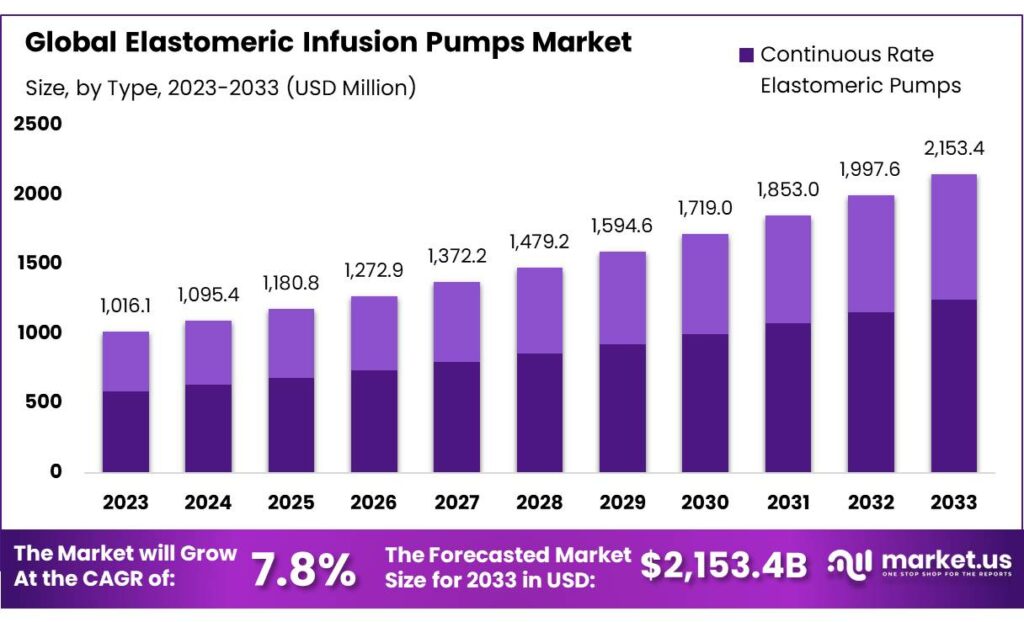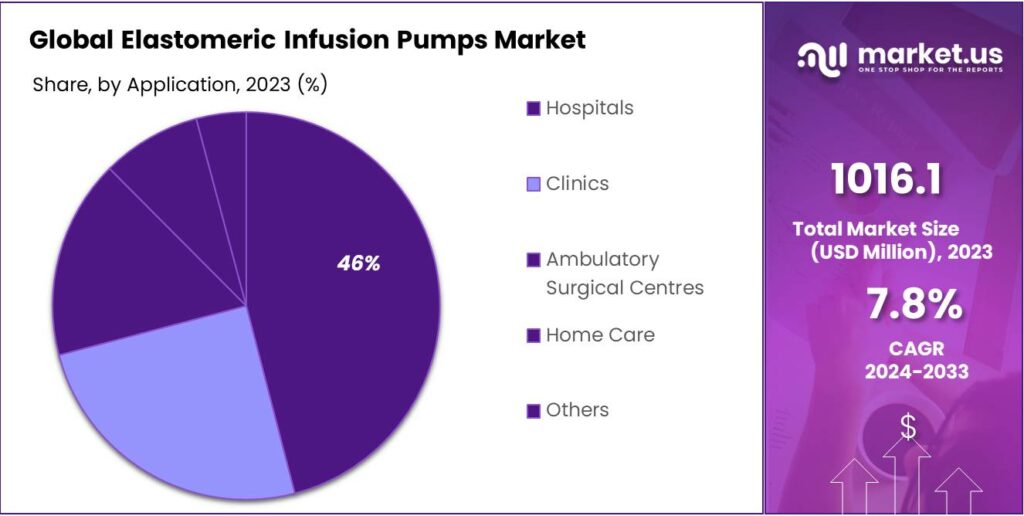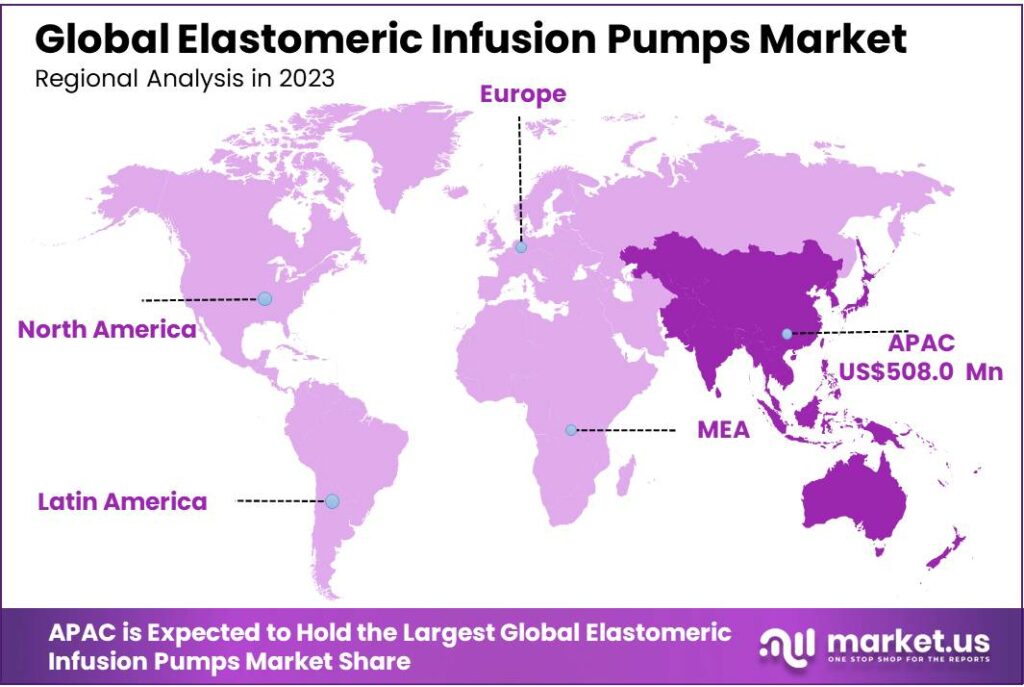Global Elastomeric Infusion Pumps Market By Type(Continuous Rate Elastomeric Pumps, Variable Rate Elastomeric Pumps), By Treatment(Pain management, Antibiotic/Antiviral, Chemotherapy, Others), By Application(Hospitals, Clinics, Ambulatory Surgical Centres, Home Care, Others), By Region and Key Companies - Industry Segment Outlook, Market Assessment, Competition Scenario, Trends and Forecast 2024–2033
- Published date: April 2024
- Report ID: 24796
- Number of Pages: 203
- Format:
- keyboard_arrow_up
Quick Navigation
Report Overview
The global Elastomeric Infusion Pumps Market size is expected to be worth around USD 2153.4 Million by 2033, from USD 1016.1 Million in 2023, growing at a CAGR of 7.8% during the forecast period from 2023 to 2033.
The Elastomeric Infusion Pumps Market refers to the industry focused on the development, manufacture, and sale of elastomeric infusion pumps. These are portable medical devices used to deliver fluids such as medications, nutrients, or other therapeutic substances directly into a patient’s body in a controlled manner.
Characterized by their simplicity and ease of use, elastomeric pumps operate without electricity or batteries. Instead, they utilize the mechanical pressure generated by the elastic properties of a balloon reservoir, which when filled, exerts pressure to gradually administer the fluid through a connected tube to the patient.
Elastomeric infusion pumps are commonly used in various healthcare settings including hospitals, outpatient care centers, and home care. They are particularly favored for applications requiring mobility, such as pain management, antibiotic therapies, and chemotherapy, where patients benefit from receiving continuous medication without the need for frequent supervision.
The market for these devices is driven by the growing need for effective and user-friendly drug delivery methods, the increasing prevalence of chronic diseases, the rising elderly population, and advancements in infusion technology that improve patient comfort and treatment efficacy.
Key Takeaways
- Market Growth: Elastomeric Infusion Pumps Market: A CAGR of 7.8% is expected from 2023 to 2033, reaching USD 2153.4 million by 2033.
- Application Areas: Widely used in hospitals, clinics, and home care for pain management, and antibiotic therapies, Hospitals held a dominant market position, capturing more than a 46.3% share.
- Types of Pumps: Continuous Rate Elastomeric Pumps held over 58.6% market share in 2023.
- Treatment Dominance: The pain management segment accounted for over 39.6% market share in 2023.
- Regional Analysis: Asia Pacific is expected to lead the global market, securing a substantial market share of 51%.

By Type
In 2023, Continuous Rate Elastomeric Pumps held a dominant market position, capturing more than a 58.6% share. This segment benefits significantly from its widespread use in hospital settings and in-home healthcare due to its reliability and ease of use.
Continuous rate pumps deliver a steady flow of medication, making them ideal for treatments that require constant and controlled medication delivery, such as pain management and antibiotic therapies. Their simplicity and efficiency in operation make them a preferred choice in diverse healthcare scenarios, contributing to their large market share.
On the other hand, Variable Rate Elastomeric Pumps, which allow for the adjustment of the flow rate according to patient needs, are gaining traction, particularly in specialized medical treatments such as chemotherapy where varying doses of medication are required at different times.
These pumps offer enhanced control and flexibility, which is particularly beneficial for complex treatment regimens. Despite their higher cost and more sophisticated technology, the demand for variable-rate pumps is expected to grow, driven by the increasing complexity of therapeutic protocols and the rising emphasis on personalized medicine.
By Treatment
In 2023, Pain management held a dominant market position, capturing more than a 39.6% share. This segment leads due to the extensive use of elastomeric pumps for post-operative and chronic pain relief. These pumps provide continuous, controlled doses of pain medication, allowing for effective management without constant supervision, which is especially beneficial in both hospital and home settings.
The Antibiotic/Antiviral treatment segment also plays a critical role in the elastomeric infusion pumps market. These pumps are essential for delivering precise doses of medications needed to treat infections, particularly in patients who require long-term antibiotic or antiviral therapies. Their use helps ensure that patients receive the right amount of medication at the right intervals, reducing the risk of resistance and side effects.
Chemotherapy is another significant application. Elastomeric pumps offer a valuable solution for the controlled delivery of chemotherapeutic drugs, which is crucial for maintaining the delicate balance necessary to manage side effects and maximize treatment efficacy. The ability to administer chemotherapy in a patient’s home also enhances quality of life by minimizing hospital visits.
The segment labeled as “Others” includes a variety of treatments such as hormone therapies, nutritional support, and hydration therapy, reflecting the versatility and adaptability of elastomeric infusion pumps across different medical needs. The growth in this segment is driven by the increasing personalization of healthcare and the rising demand for innovative drug delivery solutions in treatment protocols beyond pain management, chemotherapy, and infection control.
By Application
In 2023, Hospitals held a dominant market position, capturing more than a 46.3% share. This segment’s prominence is driven by the critical need for reliable and precise medication delivery systems in acute care settings. Hospitals frequently use elastomeric pumps for a variety of applications including pain management, antibiotic delivery, and chemotherapy, making them indispensable in these environments.
Clinics, serving as another vital setting for elastomeric pumps, leverage these devices for outpatient care, enabling efficient treatment with fewer resources. The convenience of elastomeric pumps allows clinics to administer continuous medication without the need for electronic pump systems, thus facilitating better patient throughput and care quality.
Ambulatory Surgical Centers (ASCs) also integrate elastomeric pumps, particularly valued for their portability and ease of use post-surgery. ASCs benefit from the use of these pumps in managing post-operative pain, allowing for smoother patient recovery and faster discharge processes.
Home Care represents a rapidly growing application segment as healthcare continues to shift towards more patient-centered, at-home treatments. Elastomeric pumps are ideally suited for home use due to their simplicity, safety, and effectiveness in managing chronic conditions and long-term therapies without hospitalization.
Elastomeric pumps are increasingly used in these settings to deliver consistent pain relief and other necessary medications, supporting a higher quality of life in palliative care environments.

Key Market Segments
By Type
- Continuous Rate Elastomeric Pumps
- Variable Rate Elastomeric Pumps
By Treatment
- Pain management
- Antibiotic/Antiviral
- Chemotherapy
- Others
By Application
- Hospitals
- Clinics
- Ambulatory Surgical Centres
- Home Care
- Others
Drivers
Advancements in Home Healthcare and Patient Mobility
One of the most significant drivers of the Elastomeric Infusion Pumps Market is the ongoing advancements in home healthcare services, coupled with an increasing emphasis on enhancing patient mobility. As healthcare systems globally are pushed to reduce costs and improve patient outcomes, there is a growing shift towards treating patients in the comfort and privacy of their own homes. This transition is supported by the development of more sophisticated home healthcare equipment, among which elastomeric infusion pumps stand out due to their convenience and functionality.
Elastomeric pumps, with their portable and lightweight design, offer a compelling solution for continuous, controlled medication administration without the need for electronic components or external power. This simplicity and autonomy not only reduce the burden on hospital resources but also empower patients with greater independence and control over their treatment schedules. For chronic illnesses and conditions requiring long-term medication regimens, such as cancer chemotherapy, pain management, and antibiotic therapies, elastomeric pumps ensure that patients adhere to their treatment protocols in a non-invasive manner that significantly enhances their quality of life.
Moreover, the rising prevalence of chronic diseases and the global aging population are factors that necessitate more accessible and less cumbersome treatment options. Elastomeric infusion pumps cater precisely to this need by providing a reliable method of drug delivery that can be managed outside traditional hospital settings. This capability is particularly valuable in rural or underserved areas where healthcare facilities may be sparse, but the demand for consistent and effective medical treatments remains high.
Technological advancements in the material and mechanical design of elastomeric pumps also contribute to their increased adoption. Today’s pumps are more precise in drug delivery rates and volume, offering safer options with reduced risks of over-infusion or dosage errors. The integration of advanced materials enhances the durability and reliability of these pumps, further aligning with regulatory standards and patient safety requirements.
In conclusion, the expansion of home healthcare and the focus on patient mobility are driving the growth of the Elastomeric Infusion Pumps Market. These pumps not only facilitate a shift towards more patient-centered care but also align with broader healthcare objectives such as cost reduction, improved treatment adherence, and enhanced patient satisfaction and outcomes. The combination of technological innovation and changing healthcare paradigms ensures that elastomeric infusion pumps will continue to be a critical component in the evolving landscape of medical treatment delivery.
Restraints
Regulatory and Safety Challenges
A significant restraint impacting the growth of the Elastomeric Infusion Pumps Market is the stringent regulatory and safety challenges associated with medical devices. Elastomeric pumps, like all medical equipment, must adhere to rigorous safety standards and regulatory approvals before they can be introduced to the market. These regulations ensure that the devices are safe, effective, and perform as intended, but they also impose substantial barriers to entry and can delay product launches, increase development costs, and restrict innovation.
The complexity of gaining approval from regulatory bodies such as the U.S. Food and Drug Administration (FDA), the European Medicines Agency (EMA), and other international health authorities is a formidable challenge for manufacturers. These agencies require extensive clinical data and evidence of compliance with specific safety standards, which can be costly and time-consuming to produce. For smaller companies and new entrants, the financial and resource burden posed by these requirements can be particularly prohibitive, limiting competition and innovation within the market.
Furthermore, elastomeric pumps must maintain a high level of precision and reliability in drug delivery, which necessitates sophisticated design and manufacturing processes. Any failure in the device’s function could lead to under-dosing or over-dosing, both of which carry significant health risks. This critical need for precision adds another layer of complexity to the development and quality control processes, further enhancing the regulatory scrutiny and safety evaluations these products must undergo.
The increasing focus on patient safety has led to more vigilant post-market surveillance and reporting requirements. Manufacturers are expected to continuously monitor their products after they have been released into the market, respond to any adverse events, and update their safety protocols and designs accordingly. These ongoing requirements not only increase operational costs but also pose reputational risks in cases where device malfunctions or failures occur.
In response to these challenges, companies in the elastomeric infusion pump market must invest heavily in research and development, regulatory expertise, and quality assurance processes. While these investments are crucial for ensuring compliance and maintaining market presence, they can also strain financial resources and divert focus from other strategic areas such as market expansion and product innovation.
Opportunity
Expansion into Emerging Markets
A significant opportunity for the Elastomeric Infusion Pumps Market lies in its expansion into emerging markets. Countries in regions such as Asia, Africa, and Latin America are experiencing rapid growth in their healthcare sectors due to increasing economic prosperity, rising healthcare expenditure, and growing awareness of medical treatments. As these regions invest more in healthcare infrastructure and services, the demand for medical devices, including elastomeric infusion pumps, is set to increase substantially.
Emerging markets present a fertile ground for the adoption of elastomeric infusion pumps due to their cost-effectiveness, ease of use, and the ability to administer treatments without constant medical supervision. These characteristics make them particularly appealing in areas where healthcare resources are limited or where access to healthcare facilities is challenging. Moreover, the rising prevalence of chronic diseases in these regions, coupled with an aging population, amplifies the need for reliable drug delivery systems that can support long-term, home-based treatment regimens.
The expansion into emerging markets also offers manufacturers the chance to tap into new revenue streams and diversify their market base beyond saturated developed markets. However, successful entry into these markets often requires tailored strategies to meet local healthcare needs, regulatory requirements, and market dynamics. This includes forming partnerships with local distributors, adapting marketing strategies to local cultures, and possibly even modifying products to fit specific regional requirements in terms of drug delivery specifications and user interfaces.
Furthermore, governments in these regions are increasingly supportive of healthcare advancements through favorable policies, investment in healthcare infrastructure, and initiatives to increase the local manufacturing of medical devices. These factors create a conducive environment for the growth of the elastomeric infusion pump market. For instance, public health programs aiming to improve treatment accessibility for chronic diseases or initiatives promoting home healthcare can significantly drive the adoption of these devices.
Trends
Technological Advancements and Smart Integration
A defining trend in the Elastomeric Infusion Pumps Market is the technological advancements and the integration of smart technologies into these devices. As the medical device industry continues to evolve, there is a significant push towards incorporating more sophisticated features that enhance the functionality, safety, and user-friendliness of elastomeric pumps. This trend is driven by the growing demand for more precise and reliable drug delivery systems, particularly in complex therapeutic areas such as pain management, chemotherapy, and antibiotic delivery.
Recent developments in elastomeric infusion pumps include the integration of wireless technology, which allows healthcare providers to monitor the drug delivery process remotely. This capability not only improves the safety and efficacy of treatments by enabling real-time adjustments and monitoring but also enhances comfort and convenience for patients, as it reduces the need for frequent hospital visits. The use of smart technology also facilitates the collection of data on usage patterns, patient compliance, and treatment effectiveness, providing valuable insights that can drive further improvements in treatment protocols and pump design.
Moreover, the incorporation of programmable features in elastomeric pumps is another significant advancement. These features allow the customization of drug delivery rates to suit individual patient needs, offering a more personalized approach to treatment. Programmable pumps are particularly beneficial in treatments where dosing requirements can vary over time, such as in chemotherapy, where the integration of patient-specific treatment plans into the device can significantly impact the outcome.
Another important aspect of this trend is the focus on improving the materials and mechanisms used in elastomeric pumps to enhance their reliability and extend their usable life. Innovations in elastomer technology and pump design are making these devices more robust and less prone to malfunctions or inconsistencies in drug delivery. This not only increases the trustworthiness of elastomeric pumps but also reduces waste and the overall cost of medical treatments.
Regional Analysis
The Asia Pacific region is poised to lead the global market for elastomeric infusion pumps, securing a substantial market share of 51%. This growth is fueled by the increasing demand for sophisticated medical equipment in healthcare sectors, including hospitals and home care settings across major economies like China, India, and various Southeast Asian nations.
Substantial investments in healthcare infrastructure and a strong focus on improving patient care through advanced medical technologies are anticipated to drive market expansion in this region, supported by its robust healthcare developments and initiatives in innovative medical practices.
In North America, economic strength and the expansion of healthcare sectors that require reliable and efficient drug delivery systems, such as home healthcare and ambulatory services, are expected to propel demand for elastomeric infusion pumps. The region’s dedication to improving patient outcomes and its embrace of technologically advanced healthcare solutions further boost this demand, establishing North America as a key player in the market for these devices.
Similarly, Europe is set to witness significant growth in the elastomeric infusion pumps market. This surge is driven by the increasing adoption of home healthcare solutions and the demand for patient-centric medical devices, along with the rise in healthcare services such as ambulatory and post-operative care. Europe’s focus on healthcare efficiency, patient safety, and sustainable medical practices enhances the adoption of elastomeric infusion pumps across the continent, marking it as an important market for these essential medical devices.

Key Regions and Countries
- North America
- The US
- Canada
- Europe
- Germany
- France
- The UK
- Spain
- Italy
- Russia & CIS
- Rest of Europe
- APAC
- China
- Japan
- South Korea
- India
- ASEAN
- Rest of APAC
- Latin America
- Brazil
- Mexico
- Rest of Latin America
- Middle East & Africa
- GCC
- South Africa
- Rest of MEA
Key Players Analysis
The Elastomeric Infusion Pumps Market features several key players who are instrumental in shaping the industry through innovations, wide product offerings, and strategic market activities. Understanding the dynamics of key players in this market provides insights into the competitive landscape, innovation trends, and growth strategies.
Market Key Players
- Baxter International Inc.
- B. Braun Melsungen AG
- Avanos Medical, Inc.
- Nipro Corporation
- Leventon S.A.U
- Fresenius Kabi AG
- Terumo Corporation
- Smiths Medical
- CME Medical
- Vygon Group
- Q Core Medical Ltd.
- Woo Young Medical Co., Ltd.
- Romsons Group of Industries
- Halyard Health, Inc.
- Sooil Development Co., Ltd.
- Micrel Medical Devices SA
- Coopdech
- Polymedicure Ltd.
- Shanghai Kindly Medical Instruments Co., Ltd.
- Coloplast Group
Recent Development
In January 2024, Baxter launched a new generation of elastomeric infusion pumps with enhanced durability and user-friendly interfaces, further solidifying its position as a leading provider of infusion therapy solutions.
In March 2023 B. Braun Melsungen AG, the company had achieved significant market penetration with its innovative pumps, gaining traction among healthcare providers globally.
Report Scope
Report Features Description Market Value (2023) US$ 1016.1 Mn Forecast Revenue (2033) US$ 2153.4 Mn CAGR (2024-2033) 7.8% Base Year for Estimation 2023 Historic Period 2020-2022 Forecast Period 2024-2033 Report Coverage Revenue Forecast, Market Dynamics, COVID-19 Impact, Competitive Landscape, Recent Developments Segments Covered By Type(Continuous Rate Elastomeric Pumps, Variable Rate Elastomeric Pumps), By Treatment(Pain management, Antibiotic/Antiviral, Chemotherapy, Others), By Application(Hospitals, Clinics, Ambulatory Surgical Centres, Home Care, Others) Regional Analysis North America – The US & Canada; Europe – Germany, France, The UK, Spain, Italy, Russia & CIS, Rest of Europe; APAC– China, Japan, South Korea, India, ASEAN & Rest of APAC; Latin America– Brazil, Mexico & Rest of Latin America; Middle East & Africa– GCC, South Africa, & Rest of MEA Competitive Landscape Baxter International Inc., B. Braun Melsungen AG, Avanos Medical, Inc., Nipro Corporation, Leventon S.A.U, Fresenius Kabi AG, Terumo Corporation, Smiths Medical, CME Medical, Vygon Group, Q Core Medical Ltd., Woo Young Medical Co., Ltd., Romsons Group of Industries, Halyard Health, Inc., Sooil Development Co., Ltd., Micrel Medical Devices SA, Coopdech, Polymedicure Ltd., Shanghai Kindly Medical Instruments Co., Ltd., Coloplast Group Customization Scope Customization for segments, region/country-level will be provided. Moreover, additional customization can be done based on the requirements. Purchase Options We have three licenses to opt for: Single User License, Multi-User License (Up to 5 Users), Corporate Use License (Unlimited User and Printable PDF) Frequently Asked Questions (FAQ)
What is the size of Elastomeric Infusion Pumps Market?Elastomeric Infusion Pumps Market size is expected to be worth around USD 2153.4 Million by 2033, from USD 1016.1 Million in 2023
What CAGR is projected for the Elastomeric Infusion Pumps Market?The Elastomeric Infusion Pumps Market is expected to grow at 7.8% CAGR (2023-2033).Name the major industry players in the Elastomeric Infusion Pumps Market?Baxter International Inc., B. Braun Melsungen AG, Avanos Medical, Inc. , Nipro Corporation, Leventon S.A.U , Fresenius Kabi AG , Terumo Corporation , Smiths Medical , CME Medical , Vygon Group , Q Core Medical Ltd. , Woo Young Medical Co., Ltd. , Romsons Group of Industries , Halyard Health, Inc. , Sooil Development Co., Ltd. , Micrel Medical Devices SA , Coopdech , Polymedicure Ltd. , Shanghai Kindly Medical Instruments Co., Ltd. , Coloplast Group
 Elastomeric Infusion Pumps MarketPublished date: April 2024add_shopping_cartBuy Now get_appDownload Sample
Elastomeric Infusion Pumps MarketPublished date: April 2024add_shopping_cartBuy Now get_appDownload Sample - Baxter International Inc.
- B. Braun Melsungen AG Company Profile
- Avanos Medical, Inc.
- Nipro Corporation Company Profile
- Leventon S.A.U
- Fresenius Kabi AG
- Terumo Corporation Company Profile
- Smiths Medical
- CME Medical
- Vygon Group
- Q Core Medical Ltd.
- Woo Young Medical Co., Ltd.
- Romsons Group of Industries
- Halyard Health, Inc.
- Sooil Development Co., Ltd.
- Micrel Medical Devices SA
- Coopdech
- Polymedicure Ltd.
- Shanghai Kindly Medical Instruments Co., Ltd.
- Coloplast Group
- settingsSettings
Our Clients
| Single User $4,599 $3,499 USD / per unit save 24% | Multi User $5,999 $4,299 USD / per unit save 28% | Corporate User $7,299 $4,999 USD / per unit save 32% | |
|---|---|---|---|
| e-Access | |||
| Report Library Access | |||
| Data Set (Excel) | |||
| Company Profile Library Access | |||
| Interactive Dashboard | |||
| Free Custumization | No | up to 10 hrs work | up to 30 hrs work |
| Accessibility | 1 User | 2-5 User | Unlimited |
| Analyst Support | up to 20 hrs | up to 40 hrs | up to 50 hrs |
| Benefit | Up to 20% off on next purchase | Up to 25% off on next purchase | Up to 30% off on next purchase |
| Buy Now ($ 3,499) | Buy Now ($ 4,299) | Buy Now ($ 4,999) |












